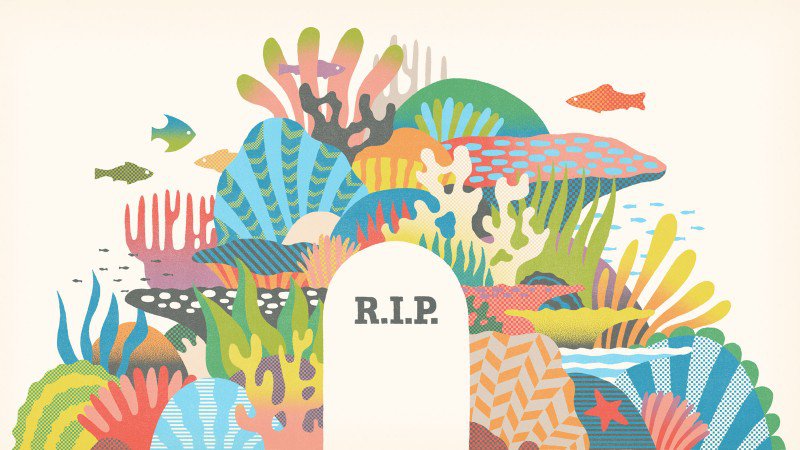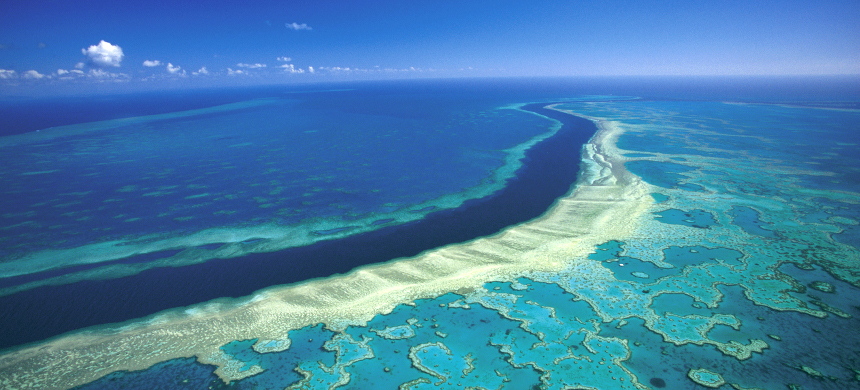Obituary: Great Barrier Reef (25 Million BC-2016) RIP
ENVIRONMENT, 17 Oct 2016
Rowan Jacobsen | Outside Online – TRANSCEND Media Service
Climate change and ocean acidification have killed off one of the most spectacular features on the planet.

For most of its life, the reef was the world’s largest living structure, and the only one visible from space. Illustration: Andrew Holder
11 Oct 2016 – The Great Barrier Reef of Australia passed away in 2016 after a long illness. It was 25 million years old.
For most of its life, the reef was the world’s largest living structure, and the only one visible from space. It was 1,400 miles long, with 2,900 individual reefs and 1,050 islands. In total area, it was larger than the United Kingdom, and it contained more biodiversity than all of Europe combined. It harbored 1,625 species of fish, 3,000 species of mollusk, 450 species of coral, 220 species of birds, and 30 species of whales and dolphins. Among its many other achievements, the reef was home to one of the world’s largest populations of dugong and the largest breeding ground of green turtles.
The reef was born on the eastern coast of the continent of Australia during the Miocene epoch. Its first 24.99 million years were seemingly happy ones, marked by overall growth. It was formed by corals, which are tiny anemone-like animals that secrete shell to form colonies of millions of individuals. Its complex, sheltered structure came to comprise the most important habitat in the ocean. As sea levels rose and fell through the ages, the reef built itself into a vast labyrinth of shallow-water reefs and atolls extending 140 miles off the Australian coast and ending in an outer wall that plunged half a mile into the abyss. With such extraordinary diversity of life and landscape, it provided some of the most thrilling marine adventures on earth to humans who visited. Its otherworldly colors and patterns will be sorely missed.
To say the reef was an extremely active member of its community is an understatement. The surrounding ecological community wouldn’t have existed without it. Its generous spirit was immediately evident 60,000 years ago, when the first humans reached Australia from Asia during a time of much lower sea levels. At that time, the upper portions of the reef comprised limestone cliffs and innumerable caves lining a resource-rich coast. Charlie Veron, longtime chief scientist for the Australian Institute of Marine Science and the Great Barrier Reef’s most passionate champion (he personally discovered 20 percent of the world’s coral species), called the reef in that era a “Stone Age Utopia.” Aboriginal clans hunted and fished its waters and cays for millennia, and continued to do so right up to its demise.
Worldwide fame touched the reef in 1770, when Captain James Cook became the first European to navigate its deadly maze. Although the reef was beloved by nearly all who knew it, Cook was not a fan. “The sea in all parts conceals shoals that suddenly project from the shore, and rocks that rise abruptly like a pyramid from the bottom,” he wrote in his journal. Cook’s ship foundered on one of those shoals and was nearly sunk, but after several months Cook escaped the reef.
After that, the reef was rarely out of the spotlight. A beacon for explorers, scientists, artists, and tourists, it became Australia’s crown jewel. Yet that didn’t stop the Queensland government from attempting to lease nearly the entire reef to oil and mining companies in the 1960s—a move that gave birth to Australia’s first conservation movement and a decade-long “Save the Reef” campaign that culminated in the 1975 creation of Great Barrier Reef Marine Park, which restricted fishing, shipping, and development in the reef and seemed to ensure its survival. In his 2008 book, A Reef in Time, Veron wrote that back then he might have ended his book about the reef with “a heartwarming bromide: ‘And now we can rest assured that future generations will treasure this great wilderness area for all time.’” But, he continued: “Today, as we are coming to grips with the influence that humans are having on the world’s environments, it will come as no surprise that I am unable to write anything remotely like that ending.”
In 1981, the same year that UNESCO designated the reef a World Heritage Site and called it “the most impressive marine area in the world,” it experienced its first mass-bleaching incident. Corals derive their astonishing colors, and much of their nourishment, from symbiotic algae that live on their surfaces. The algae photosynthesize and make sugars, which the corals feed on. But when temperatures rise too high, the algae produce too much oxygen, which is toxic in high concentrations, and the corals must eject their algae to survive. Without the algae, the corals turn bone white and begin to starve. If water temperatures soon return to normal, the corals can recruit new algae and recover, but if not, they will die in months. In 1981, water temperatures soared, two-thirds of the coral in the inner portions of the reef bleached, and scientists began to suspect that climate change threatened coral reefs in ways that no marine park could prevent.
By the turn of the millennium, mass bleachings were common. The winter of 1997–98 brought the next big one, followed by an even more severe one in 2001–02, and another whopper in 2005–06. By then, it was apparent that warming water was not the only threat brought by climate change. As the oceans absorbed more carbon from the atmosphere, they became more acidic, and that acid was beginning to dissolve the living reef itself.
Concerned for the reef’s health, a number of friends attempted interventions—none more poignant than Veron’s famed 2009 speech to London’s 350-year-old Royal Society titled “Is the Great Barrier Reef on Death Row?” Veron quickly answered his own question in the affirmative: “This is not a fun talk to give, but I’ve never given a more important talk in my life,” he told the premier gathering of scientists, accurately predicting that atmospheric carbon dioxide concentrations of 450 parts per million (which the world will reach in 2025) would bring about the demise of the reef.
No one knows if a serious effort could have saved the reef, but it is clear that no such effort was made. On the contrary, attempts to call attention to the reef’s plight were thwarted by the government of Australia itself, which in 2016, shortly after approving the largest coal mine in its history, successfully pressured the United Nations to remove a chapter about the reef from a report on the impact of climate change on World Heritage sites. Australia’s Department of the Environment explained the move by saying, “experience had shown that negative comments about the status of World Heritage-listed properties impacted on tourism.” In other words, if you tell people the reef is dying, they might stop coming.
By then, the reef was in the midst of the most catastrophic bleaching event in its history, from which it would never recover. As much as 50 percent of the coral in the warmer, northern part of the reef died. “The whole northern section is trashed,” Veron told Australia’s Saturday Paper. “It looks like a war zone. It’s heartbreaking.” With no force on earth capable of preventing the oceans from continuing to warm and acidify for centuries to come, Veron had no illusions about the future. “I used to have the best job in the world. Now it’s turned sour… I’m 71 years old now, and I think I may outlive the reef.”
The Great Barrier Reef was predeceased by the South Pacific’s Coral Triangle, the Florida Reef off the Florida Keys, and most other coral reefs on earth. It is survived by the remnants of the Belize Barrier Reef and some deepwater corals.
In lieu of flowers, donations can be made to TMS.
Go to Original – outsideonline.com
DISCLAIMER: The statements, views and opinions expressed in pieces republished here are solely those of the authors and do not necessarily represent those of TMS. In accordance with title 17 U.S.C. section 107, this material is distributed without profit to those who have expressed a prior interest in receiving the included information for research and educational purposes. TMS has no affiliation whatsoever with the originator of this article nor is TMS endorsed or sponsored by the originator. “GO TO ORIGINAL” links are provided as a convenience to our readers and allow for verification of authenticity. However, as originating pages are often updated by their originating host sites, the versions posted may not match the versions our readers view when clicking the “GO TO ORIGINAL” links. This site contains copyrighted material the use of which has not always been specifically authorized by the copyright owner. We are making such material available in our efforts to advance understanding of environmental, political, human rights, economic, democracy, scientific, and social justice issues, etc. We believe this constitutes a ‘fair use’ of any such copyrighted material as provided for in section 107 of the US Copyright Law. In accordance with Title 17 U.S.C. Section 107, the material on this site is distributed without profit to those who have expressed a prior interest in receiving the included information for research and educational purposes. For more information go to: http://www.law.cornell.edu/uscode/17/107.shtml. If you wish to use copyrighted material from this site for purposes of your own that go beyond ‘fair use’, you must obtain permission from the copyright owner.

So, so sad. I am Australian but have lived in France since 2002. I have read abut the political decisions that have helped the destruction of the Reef, but did not know how extreme the position has already become. RIP, but it is not a peaceful end.